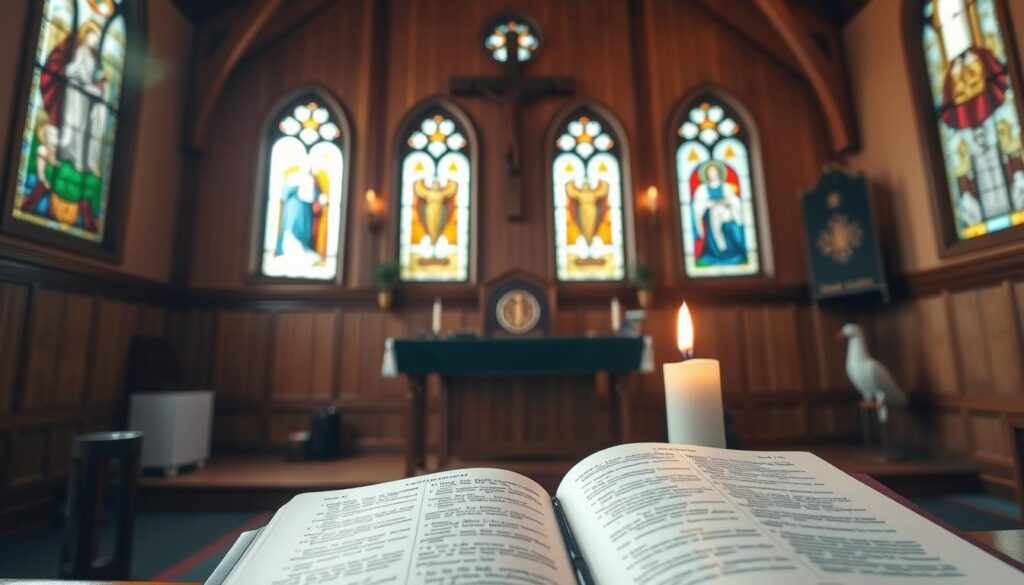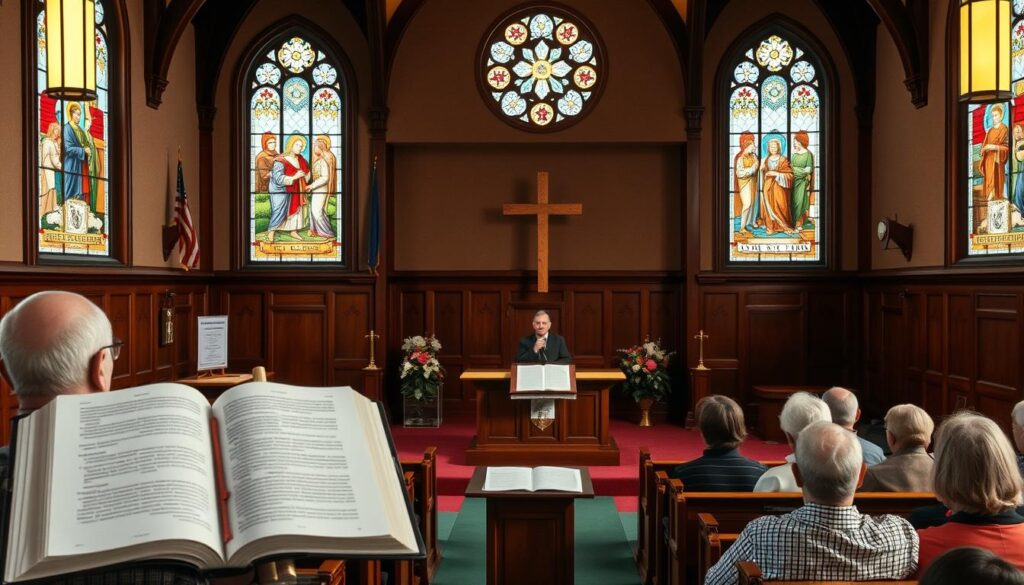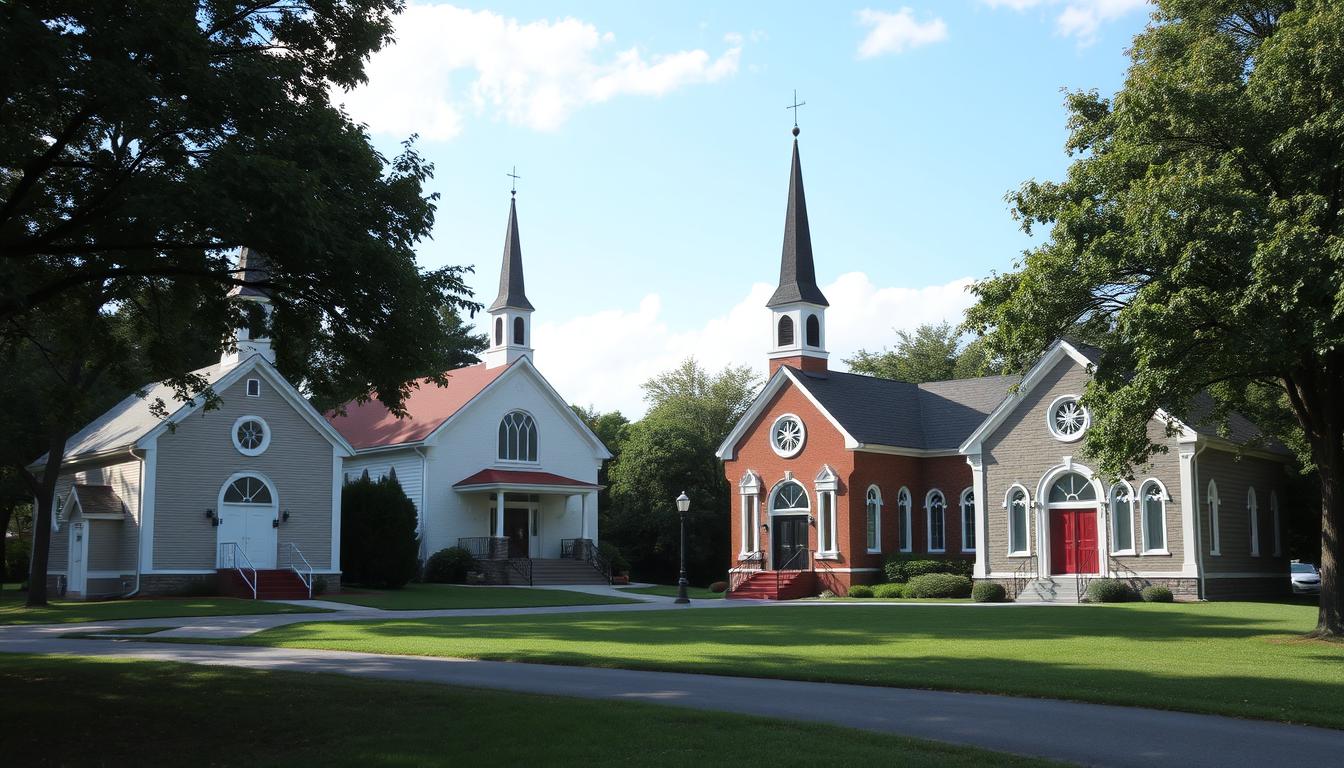What makes Lutheran, Baptist, Presbyterian, and Methodist churches unique in American Christianity? These four major Protestant faiths have grown over centuries. Their unique beliefs, worship styles, and cultural impacts have shaped the faith of millions.
Protestantism is a big part of American religion. Knowing the differences between these denominations is key for those exploring American Christianity.
Key Takeaways
- Lutheran, Baptist, Presbyterian, and Methodist denominations have distinct origins, theological beliefs, and worship practices.
- Lutherans trace their roots to the 16th century Protestant Reformation and the teachings of Martin Luther.
- Baptists are known for their theological conservatism and emphasis on the independence of local congregations.
- Presbyterians and Methodists emerged from reform movements within the Church of England in the 16th and 18th centuries, respectively.
- These denominations have diverse approaches to church governance, sacraments, and beliefs about salvation and predestination.
Origins and History
Lutheran Beginnings
The Lutheran church started with the Protestant Reformation in the 16th century. Martin Luther, a German theologian, questioned the Catholic Church’s teachings. This led to the creation of the Lutheran church.
The Eastern and Western churches split in 1054 over a Creed phrase. The Roman Catholic Church then taught that the Eucharist’s bread and wine become Christ’s body and blood.
Lutheranism grew from Martin Luther’s teachings in the 16th century. It became a unique part of Christianity. The Anglican Communion is the third-largest Christian group, found in over 165 countries. It broke away from the Roman Catholic Church in 1534 during the Protestant Reformation.

The Episcopal Church (USA) is known for its liberal views. It’s facing criticism from the Anglican Communion for its stance on marriage and sexuality. The Anglican Church of North America (ACNA) formed due to disagreements in Episcopal churches over sexuality.
Anglicans believe Christ is present in the Lord’s Supper but don’t agree with the Roman Catholic view of transubstantiation.
Theological Beliefs
Lutheran Doctrine
Lutherans follow the “five solas” of the Protestant Reformation. These are: sola scriptura (Scripture alone), sola fide (faith alone), sola gratia (grace alone), solus Christus (Christ alone), and soli Deo gloria (glory to God alone). These beliefs make Lutheran doctrine unique among Protestants.
Lutherans believe in salvation by faith, not works. They say grace alone saves us, and the Bible guides our faith and actions. This belief in sola scriptura is a key Lutheran teaching, different from some other Protestants.
Lutherans see communion as a real presence of Christ, even if not physically changed. This is different from Baptists, who see it as symbolic.
Lutherans and Baptists also disagree on salvation. Lutherans think you can lose your salvation, while Baptists believe it’s permanent.

Lutheran teachings come from the Protestant Reformation. They focus on Scripture’s authority, faith for salvation, and Christ’s importance in our lives. These beliefs make Lutherans stand out among Protestants, shaping their identity and faith.
Authority and Governance
The Lutheran church has a clear structure. Bishops lead regional synods, and local churches are guided by ordained pastors. This setup is different from other protestant denominations like Baptists and Presbyterians.
In the Lutheran church governance, pastors are key in making decisions and overseeing things. They lead worship, teach, and handle sacraments. The laity, or non-ordained members, help make decisions through elected representatives.
This hierarchical structure is different from Baptist and Presbyterian churches. These churches give more power to local congregations. Pastors in these churches focus more on spiritual guidance, while the laity are more involved in decision-making.
| Denomination | Governance Structure | Clergy-Laity Roles |
|---|---|---|
| Lutheran | Hierarchical, with bishops and regional synods | Clergy play central role in decision-making and oversight |
| Baptist | Decentralized, with local congregation autonomy | Clergy focused on spiritual guidance, laity play active role in governance |
| Presbyterian | Decentralized, with multiple levels of governance | Clergy focused on spiritual guidance, laity play active role in governance |
The Lutheran church governance shows a commitment to unity and coordination in leadership. In contrast, Baptist and Presbyterian churches value local freedom and lay participation.

The Root of Baptist Churches
The Baptist denomination started with the Anabaptist movement in the 16th century. This movement opposed infant baptism and supported “believer’s baptism” for adults who had made a personal faith commitment. Baptists also believe in the separation of church and state, a key part of their identity and history.
Today, Baptists have around 300-400 million members worldwide. In the United States, the Southern Baptist Convention is the largest Baptist group. Baptists are the biggest Protestant family of denominations in the country. They believe in baptism by immersion, unlike Methodists who accept all baptism types.
Baptist churches are mostly independent, making their own decisions about leadership. They see baptism and the Lord’s Supper as symbols of God’s grace, similar to Methodists.
Baptists have mixed views on Calvinism and Arminianism, leaning towards modified Calvinism. Methodists, on the other hand, believe in prevenient grace and reject predestination. Most Baptists believe in Eternal Security, while Methodists think believers can lose their faith.

“The Baptist denomination has its roots in the Anabaptist movement of the 16th century, which challenged the practice of infant baptism and advocated for a ‘believers’ baptism’ upon reaching adulthood and making a personal profession of faith.”
Lutheran vs Baptist vs Presbyterian vs Methodist
The Lutheran, Baptist, Presbyterian, and Methodist denominations share a common Protestant heritage. Yet, they have significant theological, liturgical, and organizational differences. These differences stem from their unique origins, beliefs, and church governance styles.
Baptists are the most conservative among major Protestant groups in the United States. They stress the inerrancy of scripture and the need for immediate adult baptism after conversion. Methodism, on the other hand, emerged from a reform movement within the Church of England in the 18th century. Methodist churches uphold traditional Christian beliefs like the Trinity and the divinity of Christ.
Lutheranism is split between conservative and modernist views. The Lutheran Church-Missouri Synod is the largest conservative Lutheran body in the country. The Evangelical Lutheran Church in America leans towards modernism. Lutherans also differ in their governance, ranging from an Episcopal structure to flatter systems.
These differences affect worship styles and liturgical practices. The unique traits of the Lutheran, Baptist, Presbyterian, and Methodist denominations showcase the diversity within Protestantism.

Worship and Liturgy
Lutheran and Methodist Services
The Lutheran and Methodist churches value liturgical worship highly. Their services include Scripture readings, hymns, and sacraments like baptism and communion. Yet, their worship styles differ, showing their unique beliefs.
Lutheran services follow a set format, focusing on the Word preached. They celebrate sacraments often, with the congregation joining in through singing and rituals. The Bible’s importance and grace in salvation are key.
Methodist services, on the other hand, are more flexible and hands-on. They still have a structure but stress preaching and lay involvement. Methodists value both church leadership and community participation in worship.
Despite their differences, both churches cherish their liturgical heritage. Their worship styles reflect their distinct theological views.
Views on Sacraments
Protestant denominations like Lutherans, Baptists, Presbyterians, and Methodists agree on two main sacraments: baptism and communion (also known as the Eucharist or Lord’s Supper). Yet, their views on these protestant sacraments differ. This shows their unique ways of understanding Scripture and the role of sacraments in faith.
Lutherans and Methodists support infant baptism, a topic of debate among Protestants. They see baptism as a universal practice for all ages. Lutherans and Methodists view baptism as a replacement for Jewish circumcision, performed on infants of both sexes. In contrast, Baptists only baptize those who have confessed faith in Jesus Christ. Presbyterians, however, accept both pedobaptism (infant baptism) and credobaptism.
The Eucharist or communion also has different views among denominations. Methodists see the bread and wine as symbols of Jesus’ body. Lutherans, on the other hand, believe they actually become Jesus’ body during the sacrament. Some Lutherans also don’t allow non-members to receive communion, unlike Methodists who welcome everyone.
The Evangelical Lutheran Church in America (ELCA) and The United Methodist Church (UMC) have been discussing sacraments since 1977. They agree on baptism and accept infant baptism. Yet, Lutherans no longer practice private confession, unlike Methodists who don’t do it at all.
The differences in protestant sacraments among these denominations show their unique beliefs. These means of grace play a significant role in their faith.
Salvation and Predestination
The Lutheran, Baptist, and Methodist denominations have different views on salvation and predestination. Lutherans and Methodists mostly follow Arminian theology, which stresses human free will. However, the Presbyterian church leans more towards Calvinistic views of predestination and eternal security.
Calvinistic Influence
Lutherans believe God’s grace is the only way to salvation, and people must accept it. Baptists also see salvation as a gift, but they say people must choose to accept it. This difference comes from Calvinistic ideas that shape Presbyterian beliefs, focusing on predestination and eternal security.
The Lutheran and Reformed traditions stand out because they believe in justification by faith alone, or sola fide. Methodists, however, add that living a holy life and striving for perfection are also key for salvation, along with faith.
The idea of predestination, where God chooses who will be saved, is a big topic of debate. This debate revolves around how much God controls our salvation and how much we have free will.
| Denomination | Salvation Beliefs | Predestination Stance |
|---|---|---|
| Lutheran | Salvation is entirely the work of God, individuals must accept this free gift of grace. | Arminian theology, emphasizing human free will. |
| Baptist | Salvation is a free gift that individuals must actively accept. | Influenced by Calvinistic concepts of predestination. |
| Methodist | Emphasis on holy living and Christian perfection, in addition to justification by faith. | Arminian theology, emphasizing human free will. |
The ongoing exploration of these theological perspectives continues to shape the salvation beliefs and predestination stances of the Lutheran, Baptist, and Methodist denominations.
Social and Cultural Influences
The Lutheran, Baptist, Presbyterian, and Methodist churches have made big impacts on society. They have shaped America’s moral and ethical views. They also drive social activism and political involvement.
Lutherans believe in “sola scriptura,” or the Bible as the only guide for faith and practice. This belief has made Lutherans leaders in defending religious freedom and the separation of church and state. The Evangelical Lutheran Church in America (ELCA) has about 4 million members. They are strong supporters of social justice and inclusivity, backing same-sex marriage and the ordination of non-heterosexual individuals.
Baptists have a long history of political involvement. They value religious liberty, free speech, and the Bible’s authority. This has led Baptists to join many social and political movements, from civil rights to debates on abortion and LGBTQ+ rights.
Methodists focus on holiness and perfection. They have greatly influenced American culture and society. The United Methodist Church is known for its work on poverty, injustice, and environmental issues.
These denominations have deeply influenced many people and communities. They have played key roles in social justice movements and the political conversation. Their impact on America is lasting.
| Denomination | Membership | Theological Stance | Social Influence |
|---|---|---|---|
| Episcopal Church | ~2 million | Diverse, ranging from social and theological liberalism to more traditional views | Engaged in social justice and ongoing debates on issues like sexuality and Scripture interpretation |
| Lutheran Church-Missouri Synod (LCMS) | ~2 million | Conservative, supporting traditional marriage and not ordaining non-heterosexual individuals | Focused on religious liberty and the separation of church and state |
| Evangelical Lutheran Church in America (ELCA) | ~4 million | Supports same-sex marriage and the ordination of non-heterosexual individuals | Advocates for social justice and inclusivity |
| Baptists | America’s largest Protestant force for most of 200 years | Committed to religious liberty, free speech, and the Bible’s unmediated authority | Politically engaged, involved in social and political movements like the civil rights movement |
| Methodists | America’s largest Protestant force for most of 200 years | Focus on holiness, entire sanctification, and perfection | Engaged with liberation theology, addressing poverty, injustice, and environmental concerns |
“The Lutheran, Baptist, Presbyterian, and Methodist churches have all left an indelible mark on the American landscape, shaping the moral, ethical, and social fabric of the nation through their teachings and activism.”
Ecumenical Movements
Protestant denominations like Lutheran, Baptist, Presbyterian, and Methodist have their own beliefs and structures. Yet, they work together through interfaith dialogue and ecumenical cooperation. This effort aims to bring more unity in diversity and christian unity.
The World Council of Churches has 348 member churches, with over half a billion members. The Catholic Church has 1.25 billion Christians, making up nearly 80% of the world’s Christians. However, counting denominations can be tricky because the Catholic Church has 24 self-governing churches. This can lead to inaccuracies in counting denominations.
The National Council of Churches started in 1908 and includes 38 church bodies. These include Methodist, Baptist, Lutheran, Episcopalian, Presbyterian, and more. Evangelicals and Catholics get a lot of attention, but ecumenical Protestant churches have a long history of fighting for justice. They also have open minds to learn from science and other religions.
The ecumenical movement in the U.S. began in 1908 with the Federal Council of Churches of Christ in America. The World Council of Churches was founded in 1948, bringing together various movements. The National Council of Churches of Christ in the United States (NCC) has 37 member denominations, including Roman Catholic and Southern Baptist.
The first assembly of the World Council of Churches in 1948 had 147 churches from 44 nationalities. But the Roman Catholic Church didn’t join. The Churches Uniting in Christ (CUIC) was formed in 1999, focusing on fighting racism and ensuring inclusivity.
| Denomination | Founding | Membership |
|---|---|---|
| World Council of Churches | 1948 | 348 member churches, over 500 million members |
| National Council of Churches | 1908 | 38 church bodies |
| Churches Uniting in Christ (CUIC) | 1999, reconstituted in 2002 | African Methodist Episcopal Church, Presbyterian Church (USA), United Methodist Church |
Contemporary Challenges
The Lutheran, Baptist, Presbyterian, and Methodist denominations face many challenges today. These include declining church attendance and membership, ongoing theological debates, and cultural shifts. They are trying to adapt and stay relevant in a changing religious landscape in the United States.
One big issue is the drop in church attendance and membership. The United Methodist Church lost over one-fifth of its congregations in August 2019. This was due to disagreements over LGBTQ clergymembers and same-sex marriage. The North American Lutheran Church, formed by conservative groups, has over 140,000 members.
ECO: A Covenant Order of Evangelical Presbyterians, with over 120,000 members, left the Presbyterian Church in 2012. The Anglican Church in North America, with more than 120,000 members, split from the Episcopal Church.
Theological debates and cultural shifts also challenge these denominations. The Eastern Orthodox churches separated from the Western churches in 1054 over a Creed phrase. Anglicanism broke away from the Roman Catholic Church in 1534 during the Protestant Reformation. Lutheranism emerged in the 16th century with Martin Luther’s teachings.
These denominations are trying different strategies to adapt and stay relevant. They are starting new outreach programs and rethinking their beliefs. They aim to engage with their members and attract new ones in a changing world.
The Lutheran, Baptist, Presbyterian, and Methodist denominations must be agile and innovative in a changing religious landscape. By tackling issues like declining attendance, theological debates, and cultural shifts, they can stay relevant. They aim to serve the spiritual needs of their communities in the future.
Theological Diversity
Within the Lutheran, Baptist, Presbyterian, and Methodist traditions, there’s a wide range of beliefs. This shows the richness and diversity in Protestantism. Each denomination has its own unique beliefs and practices, despite sharing common roots.
Spectrum of Beliefs
The Lutheran tradition emphasizes Scripture’s authority and grace, faith, and God’s glory. Baptists focus on personal conversion, the Bible’s inerrancy, and symbolic sacraments. Presbyterian and Methodist churches blend Calvinist and Arminian theology, offering a nuanced view of salvation and predestination.
This diversity is seen in each denomination’s beliefs and practices. For example, the Southern Baptist Convention holds conservative views, including the Trinity and Bible inerrancy. Yet, some Baptist churches may have more progressive views on Scripture and doctrine.
Lutheranism also spans a wide range of beliefs, from traditional to contemporary. This variety highlights the Protestant movement’s richness and dynamism. It shows the movement’s ability to embrace different theological perspectives and interpretations.
| Denomination | Theological Emphasis | Key Beliefs |
|---|---|---|
| Lutheran | Authority of Scripture, Doctrines of Grace | Sola Scriptura, Sola Fide, Soli Deo Gloria |
| Baptist | Personal Conversion, Biblical Inerrancy | Believer’s Baptism, Symbolic Sacraments |
| Presbyterian | Calvinist and Arminian Theology | Predestination, Sovereign Grace |
| Methodist | Arminian Theology, Social Justice | Salvation by Grace through Faith, Holiness |
This diversity within Protestantism shows the movement’s theological richness and dynamism. It reflects the ongoing dialogue and evolution of Christian thought and practice. Believers continually strive to interpret and apply the Bible in ways that resonate with their experiences and contexts.
Conclusion
This deep dive into Lutheran, Baptist, Presbyterian, and Methodist denominations has shed light on their unique aspects. We’ve looked at their beginnings, beliefs, and how they govern themselves. We’ve also explored their worship, views on salvation, and cultural impacts.
Knowing these differences is key to understanding American Christianity. It shows how important unity and inclusion are in the Church’s mission. Even as United Methodism faces division, this knowledge can help Christians appreciate their differences more.
By embracing these differences, we can better understand the rich diversity of American Christianity. This knowledge is crucial for the Church’s continued relevance today.
In short, this article has given a detailed look at the main differences between these denominations. It’s a valuable guide for anyone trying to make sense of American Protestantism.
FAQ
What are the key differences between the Lutheran, Baptist, Presbyterian, and Methodist denominations?
Lutheran, Baptist, Presbyterian, and Methodist churches have their own unique beginnings and beliefs. They differ in their views on authority, worship, and how people are saved. These differences make each church special in the world of American Christianity.
What are the origins and history of the Lutheran denomination?
The Lutheran church started with Martin Luther in the 16th century. Luther, a German theologian, questioned the Catholic Church’s teachings. This led to the creation of the Lutheran church.
What are the core theological beliefs of the Lutheran denomination?
Lutherans believe in the “five solas” of the Protestant Reformation. These are: Scripture alone, faith alone, grace alone, Christ alone, and glory to God alone. These beliefs guide their faith.
How does the Lutheran church structure its authority and governance?
Lutherans have a structured church with bishops and pastors. This is different from the Baptist and Presbyterian churches, which are more decentralized. This structure helps guide the church.
What are the origins and key beliefs of the Baptist denomination?
Baptists started with the Anabaptist movement in the 16th century. They believed in adult baptism and the separation of church and state. These beliefs have shaped their identity over time.
How do the Lutheran, Baptist, Presbyterian, and Methodist denominations differ in their worship practices and the role of sacraments?
Lutherans and Methodists value liturgical worship, including Scripture and sacraments. However, their rituals and views on sacraments differ. Each church has its own way of worshiping.
What are the differences in the Lutheran, Baptist, and Methodist denominations’ beliefs regarding salvation and predestination?
Lutherans, Baptists, and Methodists have different views on salvation and predestination. Lutherans and Methodists believe in free will, while Presbyterians lean towards predestination. These beliefs shape their understanding of salvation.
How have the Lutheran, Baptist, Presbyterian, and Methodist denominations impacted social and cultural issues in the United States?
These churches have played big roles in American society. They’ve been involved in social justice and moral teachings. Their influence is still felt today.
What are some of the contemporary challenges facing the Lutheran, Baptist, Presbyterian, and Methodist denominations?
These churches face challenges like declining numbers and theological debates. They’re trying to adapt to a changing religious scene in the U.S.
How is there diversity within the broader Lutheran, Baptist, Presbyterian, and Methodist traditions?
Within these traditions, there’s a wide range of beliefs and interpretations. This diversity shows the complexity and nuances within each denomination.

